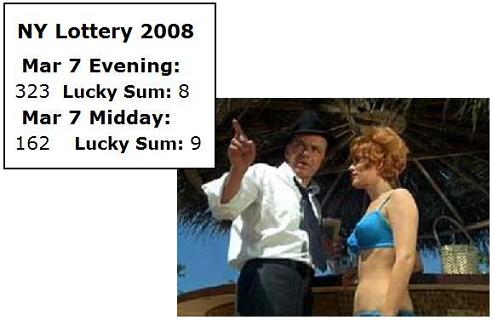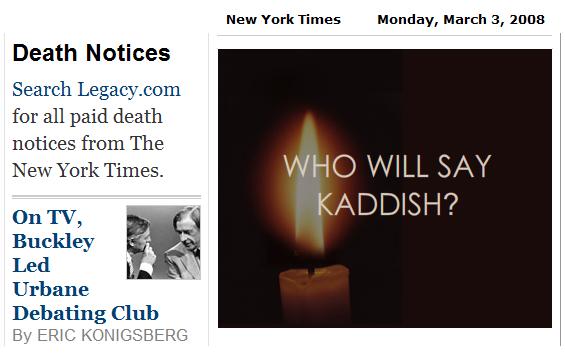From the geometry page
at cut-the-knot.org:

Related material:
this date three years ago
Annals of Geometry:

Sunday, March 30, 2008 3:14 PM
Philosophy Wars continued:
Friday, March 28, 2008 2:14 PM
A Yahrzeit for Virginia Woolf:
"From this I reach what I might call a philosophy; at any rate it is a constant idea of mine; that behind the cotton wool [of daily life] is hidden a pattern; that we-- I mean all human beings-- are connected with this; that the whole world is a work of art; that we are parts of the work of art. Hamlet or a Beethoven quartet is the truth about this vast mass that we call the world. But there is no Shakespeare, there is no Beethoven; certainly and emphatically there is no God; we are the words; we are the music; we are the thing itself."
-- Virginia Woolf, "A Sketch of the Past," 1939-40, in Moments of Being
"And I a maid at your window,
To be your Valentine."
Friday, March 28, 2008 2:02 AM
Mr. Holland's Week continues...

Thursday, March 27, 2008 3:29 PM
ART WARS continued:
Thursday, March 27, 2008 2:45 AM
STAR WARS continued:
Click image to enlarge.
The "Boy's Life" illustration is of an Arthur C. Clarke story,
"Against the Fall of Night." This, according to the review quoted below, was Clarke's first story,
begun in 1936 and first published in 1948. The title is from a poem by
From a book review by Christopher B. Jones:
"Against the Fall of Night describes well how it often takes youth to bring forth change. The older mind becomes locked in a routine, or blocks out things because it has been told that it shouldn't think or talk about them. But the young mind is ever the explorer, seeking out knowledge without the taboos placed on it by a rigid society. Alvin is a breath of fresh air in the don't-look-over-the-wall society of Diaspar.
Myths play a big role, and an interesting religious overtone pervades the story with a long since departed being whose origins are unknown and who played an important part in Earth's past. Parallels to Jesus can easily be drawn, and the forecast shown for the longevity of religions in general seems to me to be rather accurate....
Finally, when Alvin uncovers part of the truth he has been looking for, he learns of the dangers and stagnation that can befall a xenophobic society. There are still a few such societies in the world today, and this characteristic almost always comes with negative effects-- even if it has been cultivated with the intention to protect."
An example of such a xenophobic society is furnished by the Hadassah ad currently running in the New York Times obituaries section: "Who will say Kaddish in Israel?"
Another example:
Tom Stoppard, in the London Times of Sunday, March 16,
2008, on the social unrest of forty years ago in 1968--
"Altering the psyche was supposed to change the social structure but, as a Marxist, Max knows it really works the other way: changing the social structure is the only way to change the psyche. The idea that 'make love, not war' is a more practical slogan than 'workers of the world unite' is as airy-fairy as the I Ching."
Airy-fairy, Jewey-phooey.
Clarke's 1948 story was the basis of his 1956 novel, The City and the Stars. In memory of the star Richard Widmark, here are two illustrations from St. Mark's Day, 2003:
Housman asks the reader
to tell him of runes to grave
or bastions to design
"against the fall of night."
Here, as examples, are
one rune and one bastion.
|
Represents |
|
Tuesday, March 25, 2008 9:00 AM
A Midrash for Julie:
"... they were performing for God. Now God can mean whatever you want it to mean. But for me, I understood it so totally. The detail....
They did it from the inside to the outside. And from the outside to the in. And that profoundly moved me then. It was... it was the most important thing that I ever experienced."
-- Julie Taymor,
"Skewed Mirrors" interview
Here is some further commentary on the words of that entry--
On the phrase "Within You Without You"-- the title of a song by George Harrison:
"Bernard’s understanding of reality connects to this idea of 'flow': he sees reality as a product of consciousness. He rejects the idea of an 'outer' world of unchanging objects and an 'inner' world of the mind and ideas. Rather, our minds are part of the world, and vice versa."
-- Adrien Ardoin, SparkNote on
Virginia Woolf's The Waves
On "Death and the Apple Tree"-- the title of the previous entry-- in The Waves:
"The apple tree Neville is looking at as he overhears the servants at the school discussing a local murder becomes inextricably linked to his knowledge of death. Neville finds himself unable to pass the tree, seeing it as glimmering and lovely, yet sinister and 'implacable.' When he learns that Percival is dead, he feels he is face to face once again with 'the tree which I cannot pass.' Eventually, Neville turns away from the natural world to art, which exists outside of time and can therefore transcend death. The fruit of the tree appears only in Neville’s room on his embroidered curtain, a symbol itself of nature turned into artifice. The apple tree image also echoes the apple tree from the Book of Genesis in the Bible, the fruit of which led Adam and Eve to knowledge and, therefore, expulsion from Eden."
-- Adrien Ardoin, op. cit.
Monday, March 24, 2008 3:00 PM
For the gardener's wife:
|
"But what's beautiful can't be bad. You're not
bad, North Wind?"
"No; I'm not bad. But sometimes beautiful things grow bad by doing bad, and it takes some time for their badness to spoil their beauty. So little boys may be mistaken if they go after things because they are beautiful." "Well, I will go with you because you are beautiful and good, too." "Ah, but there's another thing, Diamond:-- What if I should look ugly without being bad-- look ugly myself because I am making ugly things beautiful?-- What then?" "I don't quite understand you, North Wind. You tell me what then." "Well, I will tell you. If you see me with my face all black, don't be frightened. If you see me flapping wings like a bat's, as big as the whole sky, don't be frightened. If you hear me raging ten times worse than Mrs. Bill, the blacksmith's wife-- even if you see me looking in at people's windows like Mrs. Eve Dropper, the gardener's wife-- you must believe that I am doing my work. Nay, Diamond, if I change into a serpent or a tiger, you must not let go your hold of me, for my hand will never change in yours if you keep a good hold. If you keep a hold, you will know who I am all the time, even when you look at me and can't see me the least like the North Wind. I may look something very awful. Do you understand?" "Quite well," said little Diamond. "Come along, then," said North Wind, and disappeared behind the mountain of hay. Diamond crept out of bed and followed her.
-- George MacDonald, At the Back of the North Wind |
Sunday, March 23, 2008 11:00 AM
ART WARS continued:
Sunday, March 16, 2008 1:20 AM
A Play for Kristen:




Saturday, March 15, 2008 1:00 PM
Happy Ides of March
Friday, March 14, 2008 12:00 AM
ART WARS continued:


Monday, March 10, 2008 9:00 PM
Happy Birthday, Sharon Stone

Sunday, March 9, 2008 1:00 AM
Religious Symbolism:

Saturday, March 8, 2008 1:00 PM
Imaginary Numbers:


|
"Wessel's paper [in Danish] was not noticed by the mathematical community until 1895... A French translation... was published in 1897 but an English translation of this most remarkable work was not published until 1999 (exactly 200 years after it was first published).... We have called Wessel's work remarkable, and indeed although the credit has gone to Argand, many historians of mathematics feel that Wessel's contribution was [1]:-
In the [1] article the approaches by Argand and Wessel are compared and contrasted. Of course Wessel was a surveyor and his paper was motivated by his surveying and cartography work:-
However more is claimed for Wessel's single mathematical paper than the first geometric interpretation of complex numbers. In [3] Crowe credits Wessel with being the first person to add vectors. Again this shows the depth of Wessel's thinking but again, as the paper was unnoticed it had no influence on mathematical development despite appearing in the Memoirs of the Royal Danish Academy which by any standard was a major source of publications.... 1. ... Biography in Dictionary of Scientific Biography (New York 1970-1990).3. M.J. Crowe, A History of Vector Analysis (Notre Dame, 1967)." |
Friday, March 7, 2008 8:28 PM
Real Numbers, continued:

"We keep coming back
and coming back
To the real: to the hotel
instead of the hymns...."
-- Wallace Stevens,
"An Ordinary Evening
in New Haven"
Friday, March 7, 2008 12:12 PM
Can the Center Hold?



Thursday, March 6, 2008 12:00 PM
Annals of Geometry:
... Todo lo sé por el lucero puro
que brilla en la diadema de la Muerte.
Wednesday, March 5, 2008 1:09 PM
Vocabulary Lesson--


| "I was reading Durant's section on Plato, struggling to understand his theory of the ideal Forms that lay in inviolable perfection out beyond the phantasmagoria. (That was the first, and I think the last, time that I encountered that word.)" |
Tuesday, March 4, 2008 1:00 PM
ART WARS continued:

|
Log24, Dec. 11, 2006
SINGER, ISAAC: "Are Children the Ultimate Literary Critics?" -- Top of the News 29 (Nov. 1972): 32-36. "Sets forth his own aims in writing for
children and laments 'slice of life' and chaos in children's
literature. Maintains that children like good
plots, logic, and clarity, and that they have a concern for
'so-called eternal questions.'"
-- An Annotated Listing of Criticism by Linnea Hendrickson "She returned the smile, then looked across
the room to her youngest brother, Charles Wallace, and to their father,
who were deep in concentration, bent over the model they were building
of a tesseract: the square squared, and squared again: a construction
of the dimension of time."
-- A Swiftly Tilting Planet, by Madeleine L'Engle 
A Swiftly Tilting Planet is a fantasy
for children set partly in Vespugia, a fictional country bordered
by Chile and Argentina.
|
Monday, March 3, 2008 11:09 AM
For a Shadowed Planet:


Monday, March 3, 2008 2:45 AM
Quarter to Three, continued:
Sunday, March 2, 2008 10:31 PM
All Hallows' Eve continued:


Sunday, March 2, 2008 11:00 AM
Women's History* continued:


Saturday, March 1, 2008 11:02 AM
Women's History Month

1997’s surprise best-seller, Cold Mountain, is the first
novel of North Carolina native and travel writer, Charles Frazier. Two
ancient Greek authors shape and drive the novel, set in the post-war
Southern Appalachians of 1865. Homer's Odyssey frames the novel: the
hero Inman undergoes epic adventures after the war, has his own
Penelope waiting, and travels back to a land as remote as any island,
Cold Mountain, North Carolina. But fragments of an anonymous
philosopher who can be identified as Heraclitus alienate Inman from the
Homeric world around him and determine his fate. Ada, his Penelope,
also casts off her shroud of tradition: impatient with the 'glorious
war,' no longer content to wait, Ada plunges into the new business of
living. And just as the archaic, post-Homeric Greek world produced new
ways of living and thought, as exemplified by Heraclitus, so too does
the post-bellum world of Cold Mountain, as exemplified by
Inman and Ada; their struggle, and the novel's tension, speak to and
about all those caught between two worlds, epic and philosophic,
whether driven by love or strife."